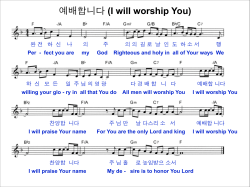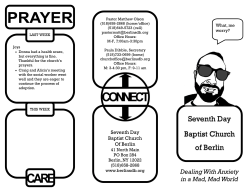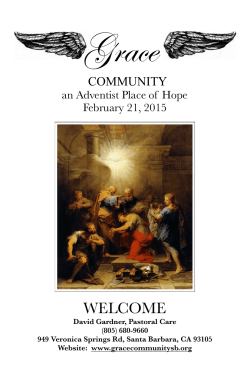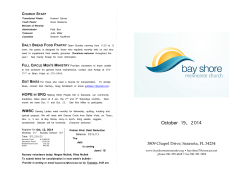
PDF - Family Research Council
Mapping America – Number 141 Percentage of Children with a Learning Disability by Family Structure and Religious Worship Child with Learning Disability by Family Structure by Family Structure and Religious Worship 12% 10% 8% 8.8% 10.4% 9.6% 6% 4% 5.5% 2% 0% Inact Married Family Remarried Stepfamily Cohabitating Parent Single Parent Family Percentage of Children with a Learning Disability Percentage of Children with a Learning Disability Child with Learning Disability 11.8% 12% 10% 8.4% 8% 6% 4% 7.7% 5.0% 2% NON-INTACT 0% NO WORSHIP (in the last two weeks) WORSHIP INTACT (in the last two weeks) Family Structure and Religious Worship Combined This chart looks at the number of children who have been diagnosed with a learning disability* at the extremes of four demographic quadrants. These four quadrants are derived from combining two sets of marital statuses (intact versus non-intact)** and two sets of religious attendance (worship vs. no worship).*** The individuals occupying the four corners (or four extremes) of these quadrants are: Child with Learning Disability Percentage of Children with a Learning Disability by Religious Worship The children from intact families that do not worship. The children from non-intact families that worship. The children from non-intact families that do not worship. 12% 10% 10.2% 8% 6% The children from intact families that worship. 6.7% * According to the 2000 NHIS Field Representative’s Manual, “learning disability” for this question was defined as: “a disorder in one or more of the basic psychological processes involved in understanding or using language, spoken or written. It may be evident by an inability to listen, think, speak, read, write, spell, or do mathematical calculations.” **The intact married family consists of children who live with their two biological parents who are married. Non-intact includes all other family types. ***The worshipping consists of children who went to a church, temple, or another place of worship for services or other activities within the past two weeks 4% 2% 0% Worship (in the last two weeks) No Worship (in the last two weeks) www.mappingamericaproject.org Percentage of Children with a Learning Disability by Family Structure and Religious Worship The 2001 cycle1 of the National Health Interview Survey (NHIS) found that children in intact families that worshipped2 were least likely to have been told by a school representative or health professional that they had a learning disability.3 Family Structure - At the time of the survey, fewer children in intact married families had ever been told they had a learning disability (5.5 percent) than children in remarried stepfamilies (8.8 percent), cohabiting families (9.6 percent) or single parent families (10.4 percent). Religious Worship - Families that worshipped every other week (or more) were less likely to have been told that their child had a learning disability (6.7 percent) than were families that did not worship (10.2 percent). Family Structure and Religious Worship Combined - Children in intact worshipping families were least likely to have been told by a school representative or health professional that they had a learning disability (5.0 percent). Children in intact non-worshipping families and non-intact worshipping families were more likely to have been told that they had a disability (7.7 percent and 8.4 percent, respectively). Children in non-intact families that did not worship were most likely to have ever been told that they had a learning disability (11.8 percent). Related Insights from Other Studies A growing body of research confirms that family structure profoundly impacts adolescents’ learning trajectories. Using the National Survey of Children’s Health, Maja Altarac and Ekta Saroha found that children from two-parent families (other than stepfamilies) were less likely to have learning disabilities than children in alternative family structures.4 Religious worship also bolsters learning development. John Bartkowski, Xiaohne Xu, and Martin Levin examined the Early Childhood Longitudinal Study to determine that the religious attendance of fathers and mothers positively predicts children’s self-control, greater interpersonal skills, and better cognitive development. Worship also provides protective effects against children’s sadness/ loneliness and children’s impulsiveness/ overactiveness. Patrick F. Fagan, Ph.D. and Rev. Paul Sullins, Ph.D. Pat Fagan is director of the Marriage and Religion Research Institute (MARRI) at Family Research Council. Dr. Sullins is an associate professor of sociology at The Catholic University of America. 1 The 2001 cycle of the National Health Interview Survey (NHIS) was chosen because that year had a measure of religious attendance, permitting our regular Mapping America analysis. 2 A worshipping family has attended at least one worship service in the past two weeks. 3 According to the 2000 NHIS Field Representative’s Manual, “learning disability” for this question was defined as: “a disorder in one or more of the basic psychological processes involved in understanding or using language, spoken or written. It may be evident by an inability to listen, think, speak, read, write, spell, or do mathematical calculations.” 4 Altarac, Maja and Saroha, Ekta. “Lifetime prevalence of learning disability among US children.” Pediatrics 119 (2007) S77-S83. Marriage and Religion Research Institute / Editor: Patrick F. Fagan, Ph.D. / Managing Editors: Christina Hadford Please feel free to make additional copies of this resource. We only ask that you comply with standard norms of attribution to the Family Research Council and to the Marriage and Religion Research Institute. www.mappingamericaproject.org marriage and religion research institute 801 g street nw washington dc 20001 800-225-4008 www.marri.us MA15D01
© Copyright 2025









